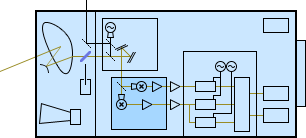SMILES sensor
High-sensitivity sensor based on superconducting technology
SMILES receiver uses highly-sensitive superconducting SIS (Superconductor-Insulator-Superconductor) mixers. The superconducting mixers need to be cooled down to a temperature of around 4 K (4 Kelvin, -269 degree Celsius). SMILES employs the mechanical cooler to cool it for the first time in space.
Signal Flow
Submillimeter-wave radiation from the atmosphere is collected by an offset Cassegrain antenna with an elliptical aperture. These signals are fed to the superconducting mixer (SIS mixer) together with a signal from a local oscillator at 637.32 GHz, and then converted into intermediate frequency signals of 11 to 13 GHz. These intermediate frequency signals are then converted to further lower frequency, and sent to acousto-optical spectrometers (AOS). The observed spectral data and instrumental house keeping data are downlinked to the ground data processing system at Tsukuba Space Center (TKSC) in JAXA via a data transmission system of the ISS.
SMILES Specifications
| Observable molecules | O3, HCl, ClO, CH3CN, HOCl, HNO3, O3isotopes | |
| HO2, BrO, SO2, UTH, Ice cloud | ||
| Observation frequency | Band A | 624.26 - 625.59 GHz |
| Band B | 625.06 - 626.38 GHz | |
| Band C | 649.05 - 650.38 GHz | |
| Frequency resolution | 1.05 to 1.20 MHz | |
| Sensitivity | Receiver noise temperature | TSYS: 297 - 380 K |
| Precision of brightness temperature | ΔT<0.42 K (in 1 ch per 0.5-second integral) | |
| Accuracy of calibrated temperature | ΔT< about 1 K | |
| Spatial resolution | Antenna diameter | 392 mm (vertical) × 200 mm (horizontal) |
| Antenna beam width | 0.089° (vertical, full width at half maximum) | |
| Altitude resolution | about 3.2 km (at the tangent point) | |
| Sampling along the orbit | At intervals of about 360 km | |
| Observation altitude range | 10 to 60 km (with even higher altitudes being observed by rough sampling) | |
| Observation latitude range | 65°N - 38°S | |
| Data rate | 44 MB/hour (mission data) | |
| Dimensions | 0.8 (wide) × 1 (high) × 1.8 (long) m 0.8 m | |
| Mass | 476 kg | |
| Power consumption | 320 to 500 W | |
| Launch date and end of observation | launch: 10 September 2009, obs. end: 21 April 2010 | |

